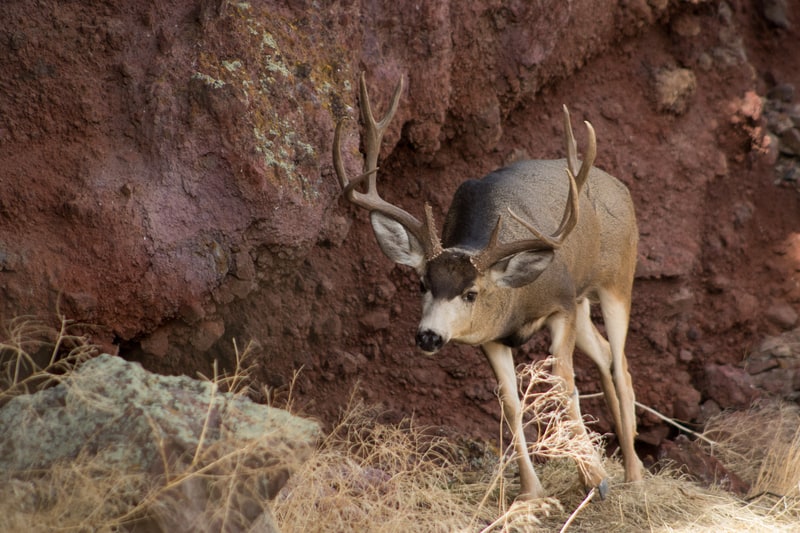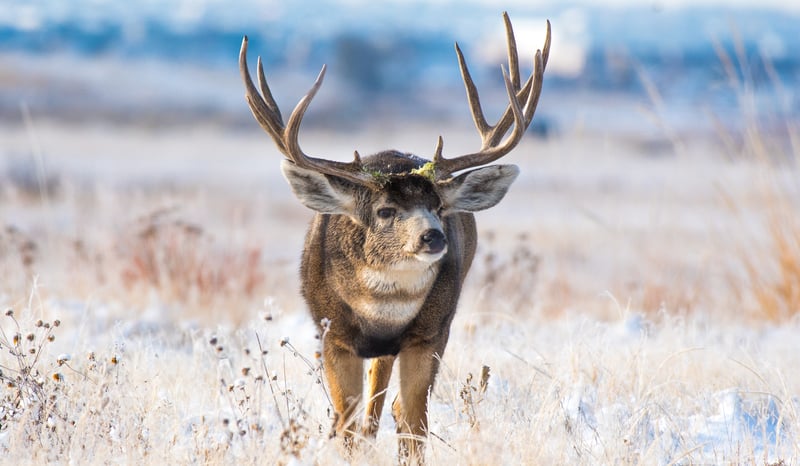Deer are generally not aggressive animals. However, in the United States, between 175 to 200 fatalities are caused each year by deer-vehicle collisions with mule deer or white-tailed deer. An additional nine or so deer/vehicle fatalities occur each year in Canada. This makes the deer, if not the most dangerous animal, one of the most dangerous animals in North America.
We have an expression in the United States, “deer in the headlights”, meaning that you look surprised and frozen in shock the way many wild deer do when standing in the middle of the road as a car approaches. In these encounters, you don’t hear of deer charging at the cars. They are mesmerized by the headlights and startled into inaction until it’s too late to get out of the way.
Do deer ever purposely attack humans? The answer is yes. Several people are attacked each year by the seemingly innocent deer.
When Do Deer Attack Humans?
Deer are wild, powerful animals, and in rare cases, they attack humans. There are certain circumstances that make a deer attack more likely.
Human-habituated deer in suburban areas will become aggressive if a human should enter their fight-or-flight zone. These deer do not flee from people like normal deer do because they are used to regular human presence and also have never been hunted. A human-habituated deer may seem like a tame or domestic animal. However, they are still wild animals, and as such, they are a danger to the unwary human that enters their bubble. For example, in 2021, in the Pike’s Peak region in Colorado, there were three different attacks of human-habituated deer on humans in a span of 8 months. See
In 2022, a couple in Evanston, Wyoming, were both attacked and gored by a mule deer buck that they accidentally startled after it had been sleeping on their driveway. See
Every year, buck deer go through a cycle where they lose and regrow their antlers. When you see large sharp antlers, you know you’re looking at a buck. September through December is prime rutting season, when their antlers are at their peak, and the bucks are looking for female deer.
Testosterone-charged bucks are more likely to attack a human during mating season when their hormones signal more aggressive behavior is in order. For example, in 2022, public officials temporarily closed Wollaton Park in Nottingham, England, after a man was attacked and seriously injured by a rutting red deer stag. See
Female deer may attack a human that is in close proximity to their young. For example, during the fawning seasons of 2005 and 2006, there were 13 examples of whitetail deer attacks on the campus of Southern Illinois University–Carbondale. See
You should always give deer fawns plenty of space because if you see a fawn, you can safely assume that a mother deer is somewhere nearby and more likely to attack if they feel their young are in danger.
What happens during a serious deer attack?
Grunting and crouching are signs of a seriously dangerous deer attack. When we say “grunting”, we mean a ton of air being pushed through the mouth, like a loud huffing noise. They will crouch on their front legs. Their front hooves may dig in the dirt. While crouched, the male deer will wave their antlers side to side or aggressively toward you. And they will charge.
If you can escape a deer attack, do so. Get to a safe space like a building or a car. If you’re good at climbing trees, try to get above six feet.
If you can’t escape, then make loud noises and make yourself as large as possible.
It’s unlikely you’ll ever be in this position. However, if the unlikely does happen, you’ll want to do your best to protect yourself from serious injuries.
If there’s a large rock nearby, you can climb on top of it to make yourself larger. If that doesn’t discourage them and the deer charges, then the deer antlers will be too close to sensitive areas where your vital organs are in danger of puncture wounds. Drop to the ground behind the rock, which puts the rock immediately between you at the deer. This may discourage them some.
Then, if all else fails, get yourself into the fetal position. Do your best to protect your head and neck. They may stomp at you with sharp hooves until they recognize that you are not a threat.
Note that this is very uncommon, and hopefully, you can just always avoid the threat of deer becoming dangerous. However, if you’re actively in the woods often during mating season, it’s always good to have a plan.

Do deer bite?
Deer do bite sometimes. In 2018, 200 people were injured by deer in Japan’s Nara Park. Many of these injuries were resultant of wild deer biting tourists. In the park, tourists can feed wild deer a specially prepared cracker. When these human-habituated deer don’t receive their crackers in a timely fashion, they sometimes lash out in various ways, including biting. See
The deer in Nara Park are sika deer. However, all deer have the potential to bite on rare occasions. Deer bites are generally not serious. These animals only have teeth in their lower jaw.
What To Do When You See A Deer
Let’s talk about how to handle different situations where you may see a deer, but it doesn’t yet look like it’s going to attack you. Note that this could change at any time because while deer are generally docile animals, as described above, they can also be dangerous animals.
If you see a deer from a distance, and it looks healthy, stay a safe distance away and take in the magic of nature. Do not approach the deer.
If you see a deer from a safe distance and it appears to be injured in some way, contact Animal Control or a rehabilitation facility nearby. Do not approach the deer in this situation; let the experts handle it.
If a deer starts approaching you, maintain a safe distance. It’s possible that people may have fed this deer, and it thinks you may feed it. You do not want to get within touching distance of this wild animal, even though we normally think of them as docile. Keep your children and pets close to you, and do not allow them to approach the deer, either. As the deer approaches, try to make yourself as large as possible and make loud noises. Hopefully, this will startle the deer, and it will run away.

Do Not Feed Wild Deer
We think of deer as docile animals we would love to have a close encounter with. So, naturally, some humans want to feed them, particularly during the winter. However, all wildlife experts caution against this. They say that feeding deer can make them dependent upon humans, which is dangerous for the deer.
It’s also dangerous because a deer’s digestive tract, by necessity, contains specialized bacteria that aid them in utilizing the native browse that they live on. When a well-intentioned human feeds deer anything other than what they regularly eat, that food will be of little value to them. What’s more, feeding deer in the winter causes them to transition away from their native browse and may actually cause them to starve to death.
Feeding deer also causes them to become habituated toward humans. This can create a dangerous situation not only for yourself but for other humans who encounter deer in the future.
What to do if you find a fawn.
It’s best to assume that the mother is around. Female deer often tuck away their fawns somewhere safe while they wander elsewhere. This way, they aren’t attracting predators to where their babies are. If you believe the fawn is in distress, the best thing to do is contact your local park service to let them know. Otherwise, avoid making sudden movements because the mother may be nearby and a threat to your safety. Back away slowly.
The best way to avoid a deer attack is to give them some space.
There are not many reports of deer attacks. However, it does seem like the numbers are going up in recent years. This may be because an increasingly dense human population and a heavy deer population are interacting more than ever before. It may also be that more people are approaching deer and other wildlife for photographs and other opportunities. It may also be that when deer have less forest space to themselves, they are venturing into areas with more humans.
Whatever the case, deer behavior is usually just the animal trying to protect itself. Be mindful of these typically peaceful animals, give them space, and count yourself lucky when you have a good view of them from a safe distance.
Recent Posts
The only venomous snakes in Washington State are Northern Pacific Rattlesnakes. The Northern Pacific Rattlesnake (Crotalus oreganus oreganus) is a sub-species of the Western Rattlesnake. Anyone...
Skunks are not classified as true hibernators. But they go into a state of torpor when the weather gets cold. Skunks are light sleep hibernators, along with opossums, bears, and raccoons. ...

